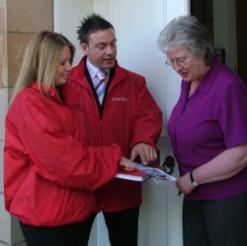The Public Fundraising Regulatory Association will introduce a compliance regime monitoring standards of doorstep fundraising around the UK within the next nine months.
It comes after a pilot in the Greater London area, between December 2013 and March this year, saw a PFRA officer shadow door-to-door fundraisers from nine organisations, including Greenpeace, Tim Lilley Fundraising and Appco.
Suzanne Moen, the PFRA’s doorstep compliance officer, also sat in on training sessions of the organisations taking part.
She benchmarked their training and work in the field against the PFRA’s Rule Book and the Institute of Fundraising’s Code of Practice, which set out regulations and best practice.
Peter Hills-Jones, head of policy and communications at the PFRA, said Moen observed fundraising teams out knocking on doors and their behaviour, such as making sure that they were not being obstructive or knocking too aggressively.
Hills-Jones said there were two main areas where the PFRA feels there is more work to be done. These include fundraising in cold calling zones and meeting EU directives on lone workers.
No cold calling zones and stickers
A recent adjudication by the Fundraising Standards Board recommended the Institute of Fundraising issues a policy on whether fundraisers should visit house displaying ‘no cold calling’ stickers. In response the IoF announced it was setting up a working group to review the rules and guidance around doorstep fundraising contained in its code, including cold calling zones and stickers.
Hills-Jones said: “I think there is a lack of clarity for fundraisers about when they should or should not knock.”
The PFRA expects fundraisers to adhere to stickers and zones that specify they apply to fundraisers. But when the rule is more general, organisations have to weigh the benefits against the risks.
The compliance pilot showed organisations had a variety of views about whether to not fundraising in all cold calling areas, or just when fundraisers are specified.
Hills-Jones said the pilot showed fundraisers were performing well on making clear propositions and being clear about what they were raising money for and how it would be used. They also explained that the charities they were working for were looking for committed, ongoing giving and that they were asking for long-term support.
The doorstep compliance regime will now be rolled out nationally within the next nine months, but it will not include the same level of checking as the PFRA carries out on street fundraisers.
“We want to make our membership feel ownership of compliance, not that we are imposing it on them,” Hills-Jones said. “That is why we are not looking to replicate the degree of checks we make on street fundraising. On the door it is not financially viable.
“We are looking at early intervention and prevention, training fundraisers properly before they get to the door.”
F2F fundraiser training schemes
The PFRA is looking at how it can work with smaller agencies to provide training for doorstep fundraisers.
Hills-Jones said the regulator also wants to work with the FRSB on publishing data on its compliance regimes alongside annual complaints figures.
He said the PFRA would not release figures from the pilot showing any breaches of the code and rule book. It will decide how to publish data next year once the scheme is running nationally.
The compliance pilot was launched after last year’s FRSB Complaints Report showed a spike in the number of complaints about doorstep.
Doorstep complaints continue to rise
This year’s report shows doorstep complaints continued to rise in 2013 and were up 27 per cent to 7,041, with the total volume of asks increasing slightly to 44.3m. Doorstep complaints as a proportion of all complaints fell from 17 per cent to 15 per cent.
In a statement about the FRSB’s report, the PFRA said it believes there are not widespread problems with doorstep fundraising.









